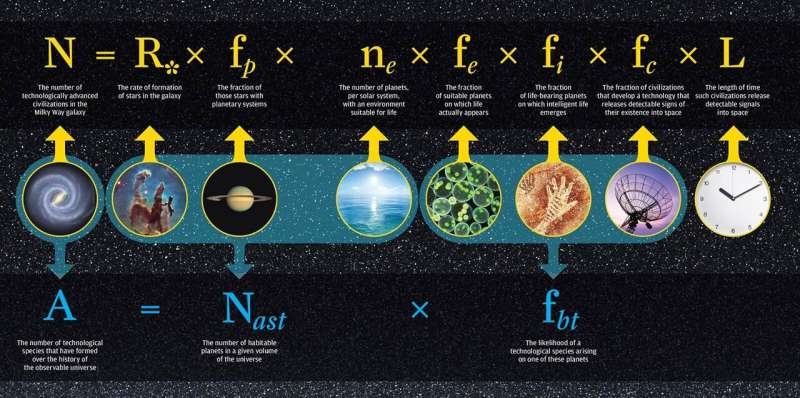On the 60th anniversary of its creation, John Gertz—a film producer, amateur astronomer, board member with BreakThrough Listen, and the three-term former chairman of the board for the SETI Institute—argues in a recent paper that a factor-by-factor reconsideration is in order.
In this paper, which was recently accepted for publication by the Journal of the British Interplanetary Society (JBIS), Gertz makes the case for a revised equation and a lot more searching. To break it down, the Drake equation consists of the following parameters:
- N is the number of civilizations in our galaxy we could communicate with
- R* is the average rate of star formation in our galaxy
- fp is the fraction of stars with planetary systems
- ne is the number of planets that can support life
- fl is the number of those planets that will develop life
- fi is the number of those planets that will develop intelligent life
- fc is the number of civilizations that might develop transmission technologies
- L is the amount of time that these civilizations would have to transmit their signals into space.
Rather than being an actual means for quantifying the number of intelligent species in our galaxy, the purpose of the equation was meant to frame the discussion on SETI. In addition to encapsulating the challenges facing scientists, it was intended to stimulate scientific dialog among those attending the meeting. As Drake would later remark:
"As I planned the meeting, I realized a few day[s] ahead of time we needed an agenda. And so I wrote down all the things you needed to know to predict how hard it's going to be to detect extraterrestrial life. And looking at them, it became pretty evident that if you multiplied all these together, you got a number, N, which is the number of detectable civilizations in our galaxy. This was aimed at the radio search, and not to search for primordial or primitive life forms."
The Drake equation has since gone on to achieve great fame and great notoriety. Whereas some scientists will laud it as one of the most important contributions to scientific inquiry, others have criticized it for its obvious uncertainties and conjectural nature. Such criticisms emphasize that by multiplying uncertain variables, the level of uncertainty grows exponentially, to the point where no firm conclusions are possible.
As John Gertz explained to the Universe Today via email, the problems associated with the Drake equation have not diminished over time. For many scientists, the profound discoveries that have taken place in the past few decades (which have reduced the level of uncertainty with some of the equation's variables) have called into question the very utility of the equation itself.
"The Drake equation was an extraordinarily useful heuristic at the outset of the modern search for extraterrestrial intelligence in the early 1960s," he said. "It guided our first-draft thoughts on the subject. Sixty years on, however, it is a creaky and aging edifice that should be swept away in favor of fresh new thinking."
For the sake of his study, Gertz reconsidered each of the variables of the Drake equation to determine if they were still useful for placing constraints on the possibility of intelligent life. For starters, there was the parameter R*, which Gertz described as "useless" for a number of reasons. These include the fact that the rate of new star formation changes over time and that Drake confined himself to sun-like stars (which have a low birthrate compared to several other types).
Also, there is the possibility that ET signals could be extragalactic in origin, and that the number of civilizations is unrelated to the birth of new stars. For these reasons, he suggests that R* should be replaced with ns, which denotes the number of candidate stars in the Milky Way that fall within our field of view. This would be considerable, since stars that are thought to be good candidates for habitability include G-type, K-type and M-type (collectively comprising over 80% of stars).
Next up, there's the number of stars that have a planet or system orbiting them (the fp parameter), which was largely unknown in Drake's time. However, in the past two decades, the number of confirmed exoplanets has grown exponentially (4,383 and counting), thanks in large part to the Kepler Space Telescope. These discoveries suggest that planets are ubiquitous to stars, which makes the parameters largely irrelevant.
Next up is another important consideration that has emerged from recent exoplanet discoveries. This is the number of Earth-like planets (aka "terrestrial" or rocky) that orbit within their parent star's habitable zone (HZ) – ne. But as multiple lines of research have shown, simply orbiting within a star's HZ is hardly the only consideration. There's also a planet's size, atmosphere, and the presence of water and tectonic activity.
The definition of HZ is also limited to planets, whereas the nature of moons like Ganymede, Europa, Enceladus, Titan and others suggest that life could exist in "ocean moon" environments. There's also the case of Mars and Venus, both of which had flowing water and relatively stable temperatures at one time. Ergo, Gertz recommends that ne should be replaced by ntb, which denotes the total number of bodies (planets, moons, planetoids, etc.) that could support life either on their surfaces or beneath them.
The parameter fl (planets that will develop life) is also hopelessly uncertain, mainly because scientists are not certain of how life began here on Earth. Current theories range from primordial pools and hydrothermal vents to seeding from space (lithopanspermia) and between star systems and galaxies (panspermia). There is also no consensus on whether or not life is ubiquitous or rare, owing to the fact that the search for extraterrestrial life (basic or otherwise) is so data-poor.
Next up, the fraction of life-bearing planets that will give rise to a technologically competent species (fi) is especially problematic. In this case, the issue comes down to evolutionary pathways and whether or not the factors leading to the emergence of homo sapiens are at all common. In short, we have no idea if evolution is convergent (favors intelligence) or non-convergent.
The penultimate parameter, the fraction of intelligent species that could be attempting to communicate with us right now (fc), is similarly riddled with problems. On the one hand, it recognizes that not all technologically competent species will be able to communicate with us, or willing (a la the "dark forest" hypothesis). On the other, it doesn't take into account two very important considerations.
For one, it doesn't consider the amount of time it takes for a transmitter or receiver to make a single circuit through a number of objects in our galaxy. Unless signals are being broadcast constantly and at very high energy levels, the chances of any being received are quite unfavorable. In addition, it doesn't take into account the possibility that technosignatures (such as radio transmissions) will be detected unintentionally.
Hence, Getz recommends that fc be replaced by the parameter fd, which is more broad in nature. In addition to considering an extraterrestrial civilization's attempts to communicate with us, it also factors in our capability of detecting a civilization's technosignatures. After all, what good are signaling efforts if the intended recipients are not even capable of receiving the message?

Last, but certainly not least, there's the tricky parameter of L, the amount of time a technologically dependent civilization will spend attempting to communicate with Earth. Over time, this parameter has come to be identified as the lifespan of civilizations, or how long they can be in an advanced state before succumbing to self-destruction or environmental collapse.
Carl Sagan himself admitted that of all the parameters in the Drake equation, this was by far the most uncertain. Put simply, we have no way of knowing how long a civilization can persist before it is no longer able to communicate with the cosmos. We could no more predict how and when an extraterrestrial civilization might end than we could our own (though some people doubt we'll make it out of this century).
Another common consideration is the likelihood that by the time an extraterrestrial signal or messenger probe is found by another species, the civilization responsible for sending it will have long since died. This argument is part of the "brief window" hypothesis, which conjectures that advanced civilizations will invariably succumb to existential threats before another civilization can receive and respond to their transmissions. Getz explained: "[T]he Drake equation was predicated upon the notion that there is a finite number of currently existing alien civilizations ensconced among the stars, some of whom will be signaling their presence to us using radio or optical lasers. However, this ignores another school of thought which holds that ET's far better strategy would be to send physical probes to our solar system to surveil and ultimately make contact with us.
"Such probes could represent information from innumerable civilizations, many of whom may have long ago perished. If this is the case, Drake's L is irrelevant, since the probe might far outlive its progenitor, and his N reduces to one, the single probe that makes its presence known to us through which alone we might communicate with the rest of the galaxy."
Ultimately, an updated version of the Drake Equation (based on Getz's analysis) would look like this:
N = ns • fp • ntb • fl • fi • fd • L
- ns is the number of spots on the sky within our FOVs
- fp is the fraction of stars with planets
- ntb is the average number of bodies within each that could engender life
- fl is the fraction of those that actually do give birth to life.
- fi is the fraction of systems with life that evolves technological intelligence
- fd is the fraction of technological life that is detectable by any means
- L is the duration of detectability

Alas, when all the parameters (and their respective levels of uncertainty) are considered, we are left with some uncomfortable implications. On the one hand, it would be empirically simpler to conclude that humanity is currently the only technologically advanced civilization in the observable universe. Or, as Getz concludes, it could serve as a call to action to reduce or eliminate these levels of uncertainty.
"The Drake equation sets out to determine N, the number of extant communicating civilizations," he said. "There is simply no way to determine this by any known means other than by making contact with our first ET and asking it what it might know of the matter. The failure of the Drake equation paradoxically makes a robust SETI program all the more important, since no amount of armchair speculation can determine N."
As to what a robust SETI program would look like, he acknowledges that current efforts—epitomized by Breakthrough Listen—are a good start. As part of Breakthrough Initiatives (a non-profit organization founded by Yuri and Julia Milner in 2015) this 10-year, $100 million program is the most comprehensive survey ever undertaken in the search for technosignatures in the universe.
The project relies on radio wave observations made by the Green Bank Observatory and the Parkes Observatory in Southeastern Australia, as well as visible-light observations from the Automated Planet Finder at the Lick Observatory in San Jose, California. Combined with the latest in innovative software and data analysis techniques, the project will survey one million nearby stars, the entire galactic plane, and 100 nearby galaxies.
However, in order for SETI research to truly advance to the point where the Drake equation can be used, two things are necessary: secure funding and dedicated observatories.
"Breakthrough Listen is a game-changer. Because of it, more SETI is accomplished in a single day than was ever before accomplished in a full year. However, over the long term, much more needs to be done. Foremost is perpetual funding that can only be assured through an endowment.
"Also, there is a need to build more telescopes dedicated to 24/7 [observation], particularly wide-field-of-view telescopes, because we can only guess from where ET's signal might arrive, and to train additional scientists who in turn might know that they can plan a career around SETI assured by a funded endowment."
Aside from the rigorous nature of looking for the proverbial needle in the cosmic haystack, one of the greatest challenges of SETI research is ensuring that funding will remain available. This is not unique to the field of SETI, but compared to space exploration and related endeavors; there is the constant battle to justify its existence. But considering that the payoff will be the single greatest discovery in the history of humanity, it is definitely worth the cost.
Explore further



